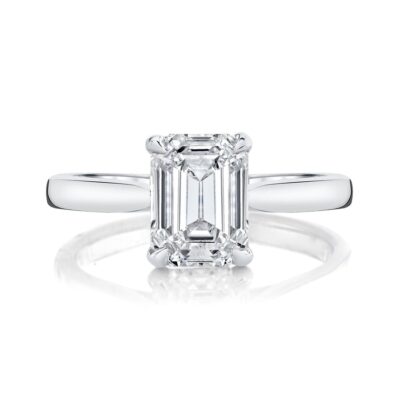Emerald & Asscher Cut Engagement Rings
Rectangular in shape, but with the corner cut away, the emerald cut is the third most popular choice of diamond for engagement rings, after the round brilliant cut and princess cut. We’ve provided some guidance below to help you decide whether an emerald cut diamond is the right option for you, and you may also wish to read our general guidance on diamond grading.

A Cut Developed For Emeralds
As the name suggests, the emerald cut was originally developed for use with emeralds before it was applied to diamonds and other gemstones. Viewed from above, its outline is octagonal – a rectangle with its corners removed. The shape evolved because emeralds (unlike diamonds) are relatively soft gemstones, and if cut to a standard rectangle their corners would be particularly vulnerable to chipping and also to damage when being set in claws.

Prioritising Reflection Over Refraction
Emerald cut diamonds are very different from round brilliants and princess cuts, which both have brilliant faceting, a specific configuration designed to increase the refraction of light. By contrast, the emerald cut is a ‘step’ cut, featuring flat rectangular facets stepping down from a large table facet (the top of the diamond), which maximises reflection but reduces refraction and instead of a culet or pointed tip, an emerald cut has a keel running along the bottom of the stone – the overall effect is a very different look from a brilliant cut.

Favouring A Higher Quality Diamond
The large table facet means that inclusions are more likely to be visible to the naked eye. Colour also tends to show very clearly in emerald cut diamonds, so you may wish to lean slightly further up the colour and clarity scales than you would if you were choosing a brilliant cut diamond. That being said, emerald cut diamonds tend to trade at a discount to round brilliant cut stones, meaning that you may well be able to obtain higher colour and or clarity grades without having to spend more than you would on a round brilliant cut diamond.
The Optimal Length To Width Ratio
Ultimately, beauty is in the eye of the beholder and you may prefer a squarer shape, or a longer thinner rectangle. It’s worth bearing in mind though that a ratio between 1.3:1 and 1.5:1 is generally considered the most desirable, and a very wide or very long stone may not be suitable for every design. A very square emerald cut (with a ratio of less than 1.05:1) is known as an Asscher cut. As no shape is universally accepted as ideal for emerald cuts, the GIA doesn’t issue a cut grade when certifying these stones – the certificate will list only ‘polish’ and ‘symmetry’ grades.
Please feel free to get in touch if you have any questions or to discuss commissioning your own bespoke design.
